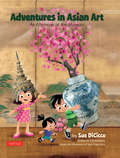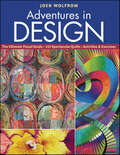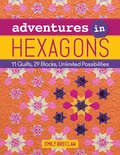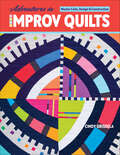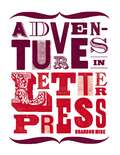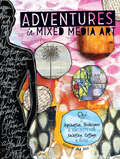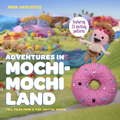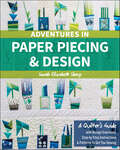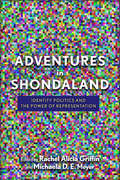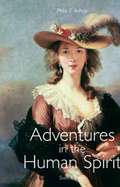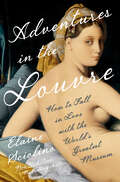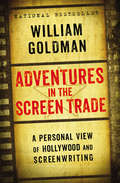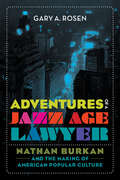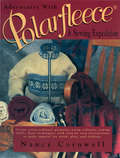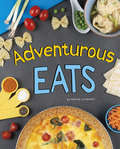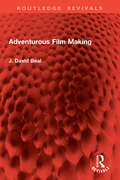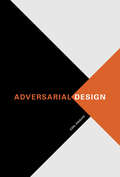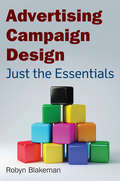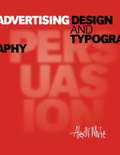- Table View
- List View
Adventures in Asian Art: An Afternoon at the Museum
by Sue DiciccoRide on a rhino, become a samurai, or climb Mt. Fuji! Asia is an entire world of wonderful places to go and things to see and do!Exploring other cultures is a favorite classroom activity for teachers and students alike. Now, author Sue DiCicco draws on her background as a writer, illustrator, sculptor, and former Disney animator to take kids on an imaginative tour of China, Japan, Korea, India, and beyond through artifacts on display at the Asian Art Museum in San Francisco.Adventures in Asian Art travels from exhibit to exhibit, inviting kids to picture themselves in a variety of Asian countries as they ride on a rhino, become a samurai, or climb Mt. Fuji! Asia is home to an endless array of wonderful places to go and things to see and do, and through the magic of DiCicco's charming verse narrative, readers join a cartoon mom as she takes her three cartoon children through the museum for an afternoon of nonstop fun and learning.This delightfully illustrated, classroom-friendly book shares a series of fun facts about each of the exhibits and explains the culture, beliefs, and daily life informing these wonderful works of art.
Adventures in Cartooning: Create a World (Adventures in Cartooning #3)
by Alexis Frederick-Frost James Sturm Andrew ArnoldIn this long-awaited third volume in Adventure in Cartooning series, you’ll find everything you need to dream up and draw fantastical worlds for your character to inhabit!The Knight is back and ready for another cartooning adventure with Edward the Horse! As every adventurer knows, you can’t have an epic journey without an epic new world to explore. They could fly to a floating metropolis or swim through an underwater empire, trek across a frozen tundra or climb to the top of a majestic mountain—the possibilities are endless! But before they do, they’ll need to draw it first. Luckily for them, the Magical Cartooning Elf is ready to help, with brand-new tips and tricks that will turn simple drawings into boundless worlds.
Adventures in Design: The Ultimate Visual Guide, 153 Spectacular Quilts, Activities & Exercises
by Joen WolfromBring more beauty and balance to your quilt designs • Everything you need to know about the essentials of good design from an internationally reknowned expert • Learn about the key elements of design and how to apply strategies for success • Practice what you've learned with exercises at the end of each chapter • An inspiring gallery illustrates design concepts by many prominent quilters and artists - including Alex Anderson, Paula Nadelstern, and Ricky Tims - with over 150 images showcasing all styles of quilts and fabric art, from traditional to modern This is the design textbook for quilters. Joen presents the eight elements of design: line, direction, shape, color, value, texture, proportion, and scale. You'll learn how to work with these elements using many guiding design principles, such as unity and balance. Whether you consider yourself to be a quilter, an artist, or a crafter, you can improve your design skills by exploring Joen's fresh, innovative approach.
Adventures in Fabric: La Todera Style
by Julie M. CreusLearn creative new techniques for 3-D fabric creations with this guide featuring 20 fun and colorful projects from the designer behind La Todera.This festive collection from designer Julie Creus brings together bright fabrics, ingenious construction methods, and a large dash of whimsy to make 3-D effects like you've never seen before in fabric. Create usable art with new techniques for fabric folding, fusing, weaving, and thread wrapping. Julie Creus shares step-by-step instructions for 20 truly unique projects—including brooches, pillows, table decor, sewing accessories, holiday decorations, children's softies, and more. These scrap-friendly projects are usable, beautiful, and fun to make. Julie's inventive methods make the sewing easy, whether you are a beginning or expert sewist.
Adventures in Hexagons: 11 Quilts, 29 Blocks, Unlimited Possibilities
by Emily Breclaw“Expert step-by-step instructions to help you create a stunning quilt that will make your friends ask, ‘How did you do that?’” —Quilter’s ConnectionMove beyond one-patch hexagon layouts with eleven show-stopping hexie projects to stitch by hand or machine. Sew blocks in a variety of sizes and pieced combinations for stunning visual effects! You’ll master the Y-seam with a variety of techniques to cut and piece hexagons. Mix it up with the author’s design primer, which gives you the tools to draft your own unique hexie quilt layout.“Breclaw’s thoughtful instruction and logical processes for assembly will guide both beginners and experienced quilters.” —Library Journal
Adventures in Improv Quilts: Master Color, Design & Construction
by Cindy GrisdelaTake on color and creativity—discover three different ways to improv quilt, creating one-of-a-kind works of art. Find inspiration in Improv and start your journey with bold colors and unique designs! Improv expert Cindy Grisdela shares the design principles and construction strategies for successful quilts every time. Explore three different ways to create improvisationally, from the easiest―using one block in different colors and orientations―to combining block units using various techniques―to aspirational, free cutting the entire quilt and designing it on the wall before sewing. Finished creations result in one-of-a-kind artwork! · Master three different improvisational styles to create original works of art · Design and construction process made easy with expert strategies Guided exercises will have you creating stunning Improv quilts in no time
Adventures in Letterpress
by Brandon MiseTactile, retro and idiosyncratic, hand-printed objects have an undeniable appeal, especially in a digital age. In recent years, the nearly obsolete craft of letterpress has been resurrected by artists and designers who have rescued cast-iron presses from basements and scrap yards. Adventures in Letterpress features over 200 examples of the resulting work: elegant cards, edgy broadsheets and everything in between. Beautiful, humorous and sometimes just plain weird, the projects featured in the book perfectly illustrate the vibrant future of this once-endangered medium.
Adventures in Letterpress
by Brandon MiseTactile, retro and idiosyncratic, hand-printed objects have an undeniable appeal, especially in a digital age. In recent years, the nearly obsolete craft of letterpress has been resurrected by artists and designers who have rescued cast-iron presses from basements and scrap yards. Adventures in Letterpress features over 200 examples of the resulting work: elegant cards, edgy broadsheets and everything in between. Beautiful, humorous and sometimes just plain weird, the projects featured in the book perfectly illustrate the vibrant future of this once-endangered medium.
Adventures in Mixed Media Art: Inspiration, Techniques and Projects for Painting, Collage and More
by Amy JonesAre you inspired by mixed-media art but don't know where to start?Adventures in Mixed Media Art is the ultimate guidebook for embarking on your own creative adventure! Featuring 20 favorite mixed-media projects from the bestselling North Light backlist, this "best of the best" collection will motivate any would-be artist to start creating!Beginning with motivational readings, you will discover and learn to refine your creative energy by discovering what inspires you. Then you are ready to create your very own art journal using guided mixed-media techniques, including hand lettering and basic painting and collage techniques.When you're ready to create and refine your signature style, you'll start creating canvas paintings, collages and assemblage pieces based on projects from popular mixed-media artists like Dina Wakley, Mary Beth Shaw, and more. Even if your project doesn't turn out as planned, the book includes helpful tips and techniques for repurposing those pieces into a new work of art you can proudly display. The book also includes collaborative projects so you can encourage others to start their own Adventures in Mixed Media!
Adventures in Mochimochi Land
by Anna HrachovecWhat do a talking doughnut, a crabby politician, and a lovelorn balloon have in common? They're all citizens of the candy-colored knitted world known as Mochimochi Land. Adventures in Mochimochi Land started out as a collection of tiny knitted characters, but as the patterns grew they needed an entire world of their own, complete with knitted cities, knitted forests, knitted oceans, and most important, knitted friends! The book follows the adventures of a tiny knitted explorer, as he travels this unbelievably cute world and uncovers its strange yarn-based origins. For intrepid knitters, the book also includes a section with 25 all-new patterns for the characters and props used in the stories. The patterns use small amounts of yarn and beginner-friendly knitting skills and knit up quickly for instant fun.
Adventures in Paper Piecing & Design: A Quilter's Guide with Design Exercises, Step-by-Step Instructions & Patterns to Get You Sewing
by Sarah Elizabeth SharpTurn your interest in foundation paper-piecing into a full-blown love affair. Learn about every stage of the process—from piecing technique to pattern design—in this comprehensive guide. Start with the basics of sewing on paper, then explore the author’s open-ended design exercises to create your own patterns or follow along with the author’s take to sew her graphic interpretations of the prompts. With an annotated overview of the author’s favorite FPP methods, countless tips, and over thirty paper-pieced quilt blocks plus seven design exercises to put your skills to the test, you’ll have the tools you need to thrive when confronted with any paper-piecing challenge! - Build your piecing skills with over thirty graphic paper-pieced blocks inspired by everything from house plants to typography to surface pattern design techniques - Learn how to translate your own reference images or sketches into FPP patterns - Sharpen your pattern-design skills with choose-your-own-adventure style exercises "
Adventures in Shondaland: Identity Politics and the Power of Representation
by Stephanie Young Vincent Pham Tina Harris Melissa Ames Mark P Orbe Michaela D.E. Meyer Rachel Alicia Griffin Richard G Jones Emily Vajjala Joan Faber McAlister Jessica L Furgerson Jennifer Billinson Jade Petermon Shadee Abdi Bernadette Calafell Myra Washington Mary Ingram-Waters Leslie Balderas Sean SwensonShonda Rhimes is one of the most powerful players in contemporary American network television. Beginning with her break-out hit series Grey’s Anatomy, she has successfully debuted Private Practice, Scandal, How to Get Away with Murder, The Catch, For The People, and Station 19. Rhimes’s work is attentive to identity politics, “post-” identity politics, power, and representation, addressing innumerable societal issues. Rhimes intentionally addresses these issues with diverse characters and story lines that center, for example, on interracial friendships and relationships, LGBTIQ relationships and parenting, the impact of disability on familial and work dynamics, and complex representations of womanhood. This volume serves as a means to theorize Rhimes’s contributions and influence by inspiring provocative conversations about television as a deeply politicized institution and exploring how Rhimes fits into the implications of twenty-first century television.
Adventures in the Human Spirit
by Philip E. BishopFor a one semester survey course in Introduction to Humanities. This single-volume text is a historical survey of the western humanities. Written to be accessible to students with little background in the arts and humanities, Adventure in the Human Spirit provides a balanced introduction to the major arts, philosophy, and religion. This text approaches the humanities by focusing on principal events, styles, movements, and figures, bringing the past to life.
Adventures in the Louvre: How to Fall in Love with the World's Greatest Museum
by Elaine SciolinoA former New York Times Paris bureau chief explores the Louvre, offering an intimate journey of discovery and revelation. The Louvre is the most famous museum in the world, attracting millions of visitors every year with its masterpieces. In Adventures in the Louvre, Elaine Sciolino immerses herself in this magical space and helps us fall in love with what was once a forbidding fortress. Exploring galleries, basements, rooftops, and gardens, Sciolino demystifies the Louvre, introducing us to her favorite artworks, both legendary and overlooked, and to the people who are the museum’s lifeblood: the curators, the artisans producing frames and engravings, the builders overseeing restorations, the firefighters protecting the aging structure. Blending investigative journalism, travelogue, history, and memoir, Sciolino walks her readers through the museum’s front gates and immerses them in its irresistible, engrossing world of beauty and culture. Adventures in the Louvre reveals the secrets of this grand monument of Paris and basks in its timeless, seductive power.
Adventures in the Screen Trade
by William GoldmanNow available as an ebook for the first time!No one knows the writer's Hollywood more intimately than William Goldman. Two-time Academy Award-winning screenwriter and the bestselling author of Marathon Man, Tinsel, Boys and Girls Together, and other novels, Goldman now takes you into Hollywood's inner sanctums...on and behind the scenes for Butch Cassidy and the Sundance Kid, All the President's Men, and other films...into the plush offices of Hollywood producers...into the working lives of acting greats such as Redford, Olivier, Newman, and Hoffman...and into his own professional experiences and creative thought processes in the crafting of screenplays. You get a firsthand look at why and how films get made and what elements make a good screenplay. Says columnist Liz Smith, "You'll be fascinated.
Adventures of Perception: Essays / Interviews
by Scott MacdonaldIn this collection of thematically related personal essays and conversations with filmmakers, the author takes us on a fascinating journey into many under-explored territories of cinema.
Adventures of a Jazz Age Lawyer: Nathan Burkan and the Making of American Popular Culture
by Gary A. RosenAdventures of a Jazz Age Lawyer is the lively story of legal giant Nathan Burkan, whose career encapsulated the coming of age of the institutions, archetypes, and attitudes that define American popular culture. With a client list that included Charlie Chaplin, Al Jolson, Frank Costello, Victor Herbert, Mae West, Gloria Morgan Vanderbilt, Arnold Rothstein, and Samuel Goldwyn, Burkan was “New York’s Spotlight Lawyer” for more than three decades. He was one of the principal authors of the epochal Copyright Act of 1909 and the guiding spirit behind the American Society of Composers, Authors, and Publishers (Ascap), which provided the first practical means for songwriters to collect royalties for public performances of their works, revolutionizing the music business and the sound of popular music. While the entertainment world adapted to the disruptive technologies of recorded sound, motion pictures, and broadcasting, Burkan’s groundbreaking work laid the legal foundation for the Great American Songbook and the Golden Age of Hollywood, and it continues to influence popular culture today.Gary A. Rosen tells stories of dramatic and uproarious courtroom confrontations, scandalous escapades of the rich and famous, and momentous clashes of powerful political, economic, and cultural forces. Out of these conflicts, the United States emerged as the world’s leading exporter of creative energy. Adventures of a Jazz Age Lawyer is an engaging look at the life of Nathan Burkan, a captivating history of entertainment and intellectual property law in the early twentieth century, and a rich source of new discoveries for anyone interested in the spirit of the Jazz Age.
Adventures with Leaders & Enders: Make More Quilts in Less Time!
by Bonnie K. HunterAn easy method to faster quilt-making, and incredible patterns to make use of your scrap stash. What if you could piece quilts even faster, work on more than one quilt simultaneously and save money, fabric and thread all at the same time? Bonnie K. Hunter will show you how to put the concept of Leaders & Enders to work quickly and easily, expanding your creativity, and upping your productivity all at the same time. If you have ever found yourself paralyzed by your stash, overwhelmed by scraps you just can't bear to toss out, arm yourself with a new rotary blade for your cutter, make yourself a cup of tea and start reading. This book is not only full of beautiful scrap quilts that can be made in between the lines of other sewing, but also contains many ideas for getting your ever burgeoning scrap stash under control, into useable sized pieces that work well with one another, and ready to be sewn into quilts you've always wanted to make. Bonnie K. Hunter has done it again!
Adventures with Polarfleece: A Sewing Expedition
by Nancy CornwellJourney into virtually uncharted territory and discover the wonderful uses of fleece! Allow author Nancy Cornweel to lead you on a sewing expedition. Adventures with Polarfleece covers territories as fabric and garment care, sewing machine and serger basics, pattern choices and simple design changes. Included are 200 photographs and 150 color illustrations to guide you on a tour of quick and easy techniques for seams, ready-to-wear edge finishing and no-hassle zippers. Nancy also shows a safety technique on how to avoid the dreaded "frog mouth" buttonhole! Adventures with Polarfleece also includes a special excursion in ultrasuede - drawcords, patches, button loops, piping and pockets; sculpturing, polar pintucks and embroidery. A collection of fifteen projects are included. This sewing expedition has been photographed every step of the way and is clearly mapped and illustrated. Included are instructions for jackets, pull-overs, a cape, a five-minuet hat, blankets, pillows, exceptional accessories and more! Explore and discover the endless project possibilities for the entire family. Fleece is one of the sewing world's premier fabrics for comfort and warmth. It is easy to sew with beautiful results. Nancy Cornwell will lead you down a path of discovery filled with excitement, intrigue and inspiration. If the urge to explore is part of your nature, Adventures with Polarfleece is sure to generate great excitement. The heart of a fallen-away sewer will soon be recaptured and new sewers will be intrigued and inspired.
Adventurous Eats (Easy Eats)
by Katrina JorgensenLooking for new recipes that will challenge those blossoming cooks? Adventurous Eats will push developing cooks to the next level of kitchen creativity. Try a new flavor combination or a cuisine from across the globe. These recipes are both tasty and tempting!
Adventurous Film Making (Routledge Revivals)
by J. David BealAdventurous Film Making (1980) looks at some more ambitious and interesting techniques and shows how these serve film makers in expressing their ideas. This volume spans every kind of film: travel, action, recreations of the past, visual and verbal comedy, the natural world, cartoon and puppet animation, true-life adventures, sporting events, fantasy and science fiction. It focuses on the more advanced use of equipment, and discusses all aspects of shooting and editing, and also reveals for the first time the particular methods chosen by some of the most talented and successful amateur film makers, each an acknowledge specialist in their chosen field.
Adversarial Design
by Carl DisalvoIn Adversarial Design, Carl DiSalvo examines the ways that technology design can provoke and engage the political. He describes a practice, which he terms "adversarial design," that uses the means and forms of design to challenge beliefs, values, and what is taken to be fact. It is not simply applying design to politics--attempting to improve governance for example, by redesigning ballots and polling places; it is implicitly contestational and strives to question conventional approaches to political issues. DiSalvo explores the political qualities and potentials of design by examining a series of projects that span design and art, engineering and computer science, agitprop and consumer products. He views these projects-- which include computational visualizations of networks of power and influence, therapy robots that shape sociability, and everyday objects embedded with microchips that enable users to circumvent surveillance--through the lens of agonism, a political theory that emphasizes contention as foundational to democracy. Each of these projects engages one of three categories as a medium--information, robots, and ubiquitous computing--and in each of them certain distinctive qualities of computation are used for political ends or to bring forth political issues. DiSalvo's illuminating analysis aims to provide design criticism with a new approach for thinking about the relationship between forms of political expression, computation as a medium, and the processes and products of design.
Adversarial Design (Design Thinking, Design Theory)
by Carl DisalvoAn exploration of the political qualities of technology design, as seen in projects that span art, computer science, and consumer products.In Adversarial Design, Carl DiSalvo examines the ways that technology design can provoke and engage the political. He describes a practice, which he terms “adversarial design,” that uses the means and forms of design to challenge beliefs, values, and what is taken to be fact. It is not simply applying design to politics—attempting to improve governance for example, by redesigning ballots and polling places; it is implicitly contestational and strives to question conventional approaches to political issues. DiSalvo explores the political qualities and potentials of design by examining a series of projects that span design and art, engineering and computer science, agitprop and consumer products. He views these projects—which include computational visualizations of networks of power and influence, therapy robots that shape sociability, and everyday objects embedded with microchips that enable users to circumvent surveillance—through the lens of agonism, a political theory that emphasizes contention as foundational to democracy. DiSalvo's illuminating analysis aims to provide design criticism with a new approach for thinking about the relationship between forms of political expression, computation as a medium, and the processes and products of design.
Advertising Campaign Design: Just the Essentials
by Robyn BlakemanThe author's step-by-step approach to campaign design dissects the creative process necessary to design a successful integrated marketing communications campaign one topic at a time, creating an invaluable research tool that students and professors alike will refer to time and time again.
Advertising Design and Typography
by Alex W. WhiteThe most comprehensive overview of advertising design strategies on the market today! This unique, comprehensive overview of advertising design strategies, written by a best-selling, award-winning designer, will help students and professionals in advertising, design, and typography understand and use persuasive visual messaging. Design principles such as unity, contrast, hierarchy, dominance, scale, abstraction, and type and image relationships are covered in depth. Readers will also learn how print design compares to television, web, and interactive design, and how to apply each style to create persuasive designs. The extensive section on typography offers essential information on how readers perceive type, typographic history, principles, and practice. Helpful appendices include an extensive glossary, bibliography, and art director's checklist. Complete with more than 1,500 examples and illustrations of outstanding advertising design from around the world, Advertising Design and Typography is a groundbreaking book that will train the reader's mind to see more accurately and more critically-ultimately changing the way designers think and develop visual ideas. Best-selling design author has unique philosophy and expertise 1,500 full-color illustrations showcase outstanding advertising design from around the world Unique comparisons of print, web, TV and other campaigns-which techniques work best? Ideas for forging corporate identity through advertising
